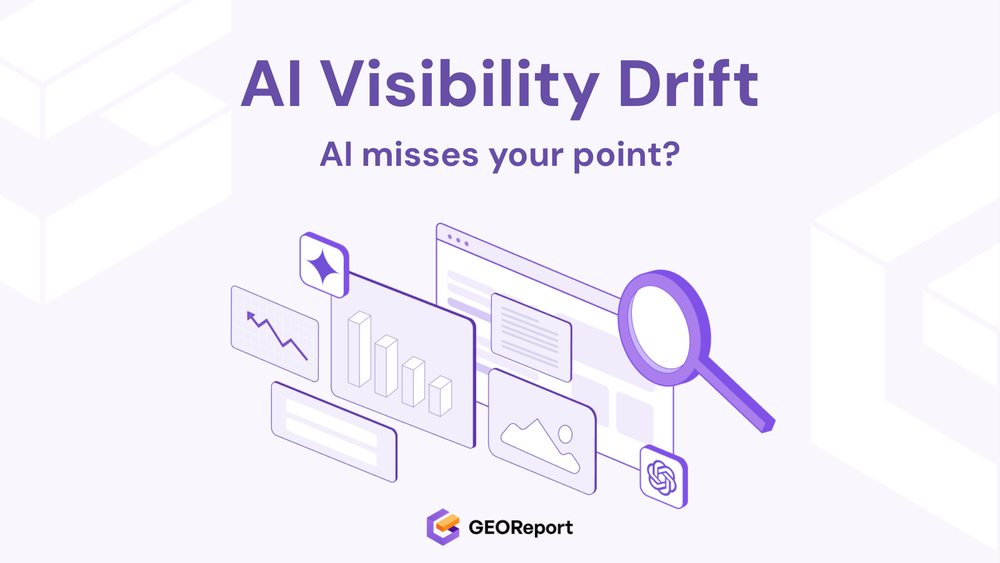BLUF:
AI Visibility Drift happens when generative engines mention your brand, but misrepresent what you do or fail to link back to your source. It’s not a visibility win, it’s a context loss, and fixing it is the next frontier of GEO optimization.
What Is AI Visibility Drift?
AI Visibility Drift describes the moment your brand is recognized by AI, but not correctly interpreted. You appear in an answer, yet outside your core expertise or disconnected from your official data.
For example, a fintech startup may be cited in a “blockchain analytics” context, even though it specializes in cross-border payments. Or an educational platform might show up in “AI tutoring” discussions, while its main strength is STEM curriculum design.
This is AI Visibility Drift, a form of semantic misalignment between what your brand means and how AI understands it.
Why AI Visibility Drift Happens?
Generative models rely on probabilistic associations between entities. When they lack clear contextual anchors (structured data, entity markup, consistent messaging), they infer relationships based on proximity rather than precision.
That means if your brand content is too broad, under-structured, or inconsistently phrased, AI might associate you with similar entities in the wrong niche.
Key causes of AI Visibility Drift include:
- Missing or ambiguous schema (e.g., undefined product categories).
- Overlapping brand terminology (common nouns used as names).
- Contradictory context across different web pages or press mentions.
- Outdated external descriptions on third-party sites.
In GEO terms, your entity “floats”, it’s seen, but not grounded.
When Visibility Becomes Noise
AI Visibility Drift creates the illusion of brand reach. Your name appears, citations exist, but they fail to drive relevance, traffic, or trust.

In GEOReport’s audits, we’ve seen brands with high AI mention counts but low contextual recall. They’re visible, but not understood.
For instance, a software tool might be cited in generative answers about “data visualization” when it actually focuses on workflow automation. Users who follow that mention quickly realize the mismatch, reducing click-through rates and damaging perceived credibility.
Visibility without accuracy is noise. In the AI economy, precision is the new currency of trust.
The Hidden Cost of AI Visibility Drift
When your brand is misinterpreted, AI models start reinforcing that wrong context. Each new dataset, citation, or co-mention deepens the drift. This phenomenon creates a self-reinforcing bias inside generative engines.
Over time, AI may start presenting your brand’s outdated or incorrect positioning as fact. This can impact product reputation, investor perception, and even recruitment visibility.
The worst part? Drift doesn’t only cost awareness, it distorts identity.
Case Study: When a Startup Became a “Blockchain Tool”
In one GEOReport analysis, a SaaS startup offering API monitoring tools was repeatedly mentioned in generative answers about “blockchain performance analytics.”
After investigation, we found the cause: a 2023 blog post comparing “data transparency” across APIs and blockchains. That single semantic overlap caused AI models to cluster the brand within the blockchain ecosystem.
As a result, the brand’s AI recall rate rose, but its intent accuracy dropped 40%. They became more visible, but less relevant. That’s the paradox of AI Visibility Drift, attention detached from meaning.
How to Detect AI Visibility Drift
Unlike AI Visibility Decay, which hides in silence, drift shows up as noise. It’s visible, but misleading. You can detect it by auditing semantic recall accuracy instead of raw mentions.
At GEOReport.ai, we use Context Precision Index (CPI) to measure how often your brand is correctly cited within intended topics.
Red flags for AI Visibility Drift include:
- High mention frequency with low traffic conversion.
- Mentions in irrelevant or outdated niches.
- AI-generated descriptions that mismatch your messaging.
- Entity summaries missing your key products or features.
Drift is easy to miss if you only measure exposure. It’s what happens when quantity hides quality.
How to Prevent AI Visibility Drift
To prevent AI Visibility Drift, you must build consistent semantic anchors
that define what your brand is, and what it’s not.

- Tighten entity markup.
Add clear schema types and subtypes for products, services, and categories. - Standardize brand language.
Use consistent phrasing across all pages, press, and documentation. - Disavow outdated descriptions.
Update partner sites, directories, and media mentions to reflect your true focus. - Publish contextual FAQs.
Use Q&A content to clearly define your brand’s domain and limit confusion. - Track context accuracy monthly.
GEOReport’s CPI metric helps detect early drift and quantify misinterpretation.
Contextual clarity is not optional, it’s your brand’s defense against semantic entropy.
GEOReport’s Role in Fixing AI Visibility Drift
GEOReport.ai continuously monitors how generative systems perceive your brand. It measures semantic alignment, cross-model consistency, and detects emerging drift patterns before they compound.
By comparing your AI mentions with your official content taxonomy, we can identify where AI starts to misread your intent, and help you realign it.
Our tools track:
- Context Precision Index (CPI)
- Semantic Alignment Health (SAH)
- Cross-Model Entity Correlation (CMEC)
Together, they reveal not just if you’re visible, but how you’re being understood.
The Future of GEO: From Visibility to Interpretation
AI Visibility Drift shows why the next evolution of GEO is not about being seen, but being interpreted correctly.
Brands that fail to manage interpretation risk losing narrative control to generative summaries. The new frontier of GEO isn’t keyword optimization, it’s meaning optimization.
Generative engines don’t care who shouts the loudest, they remember who speaks the clearest.
FAQs
What is AI Visibility Drift?
It’s when AI mentions your brand but misrepresents its core meaning or context.
How is it different from AI Visibility Decay?
Decay is silence, drift is distortion. Decay makes you invisible, drift makes you misunderstood.
Can both happen at the same time?
Yes. A brand can decay in one model while drifting in another.
How can GEOReport fix AI Visibility Drift?
By analyzing your semantic footprint and retraining your entity clarity through structured content, FAQs, and aligned language models.
Author’s Note
AI doesn’t just forget brands, it sometimes gets them wrong. And in generative search, being misunderstood is worse than being unseen. Fixing AI Visibility Drift means reclaiming not just your mentions, but your meaning.


